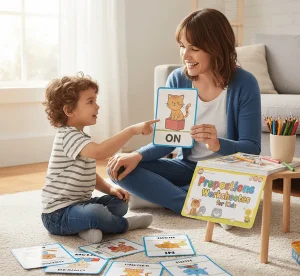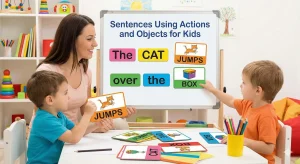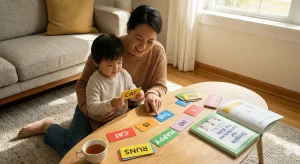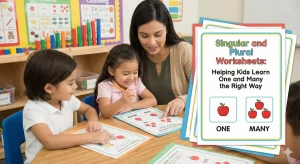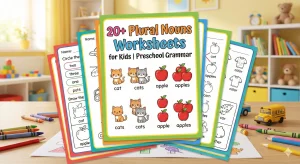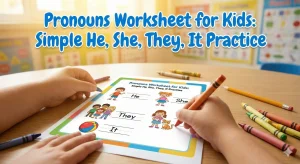When to Seek Help for Grammar and Pronunciation Issues in Kids
Last Updated: August 21, 2025
Have you noticed your child saying “wabbit” instead of “rabbit” or mixing up words like “he” and “she”? While small slip-ups are a normal part of learning, persistent pronunciation problems or grammar delays can sometimes signal the need for extra support. Many parents wonder, “When should I seek speech therapy for my child?” The truth is, knowing the difference between what’s “just a phase” and what’s a speech or language disorder can feel confusing.
In this guide, we’ll break down the key speech and grammar milestones for toddlers and preschoolers, highlight the red flags in articulation and language development, and explain exactly when to seek help from a speech-language pathologist (SLP). You’ll also learn practical tips to support your child’s speech clarity and sentence building at home, plus answers to the most common questions parents ask about speech therapy for kids.
Free Speech Help for Kids
Concerned about speech delays? Book a free consultation with our expert speech therapist and get guidance tailored to your child’s needs.
What’s Normal in Speech and Grammar Development?
Every child develops language skills at their own pace, but there are general speech milestones that can help parents understand what’s typical between ages three and five. Knowing these benchmarks makes it easier to spot when small grammar issues or unclear sounds are part of normal growth — and when they might need extra attention.
Speech and Grammar by Age
- By age 3: Most toddlers can use simple three-word sentences (“I want juice”) and are starting to put words in the right order. Their speech may not always be clear to people outside the family, but close caregivers usually understand them. It’s also normal at this stage for children to leave out little words (“me go park”) or mix up pronouns.
- By age 4: Speech should be getting easier to understand, even for strangers. A four-year-old can usually tell short stories about their day and use basic grammar rules like plurals (“dogs”) or past tense (“played”). That said, it’s common for them to still struggle with tricky speech sounds like R, L, TH, and S — these are called late-developing sounds. A child saying “wabbit” for “rabbit” or “thoup” for “soup” is often within normal range at this age.
- By age 5: Most children can form longer sentences, retell simple stories, and use more complex grammar like subject–verb agreement (“She runs fast”) without much prompting. Pronouns (“he,” “she,” “they”) should mostly be accurate, though occasional mix-ups may still happen. By this age, speech clarity in toddlers typically improves so that both family members and strangers can understand them most of the time.
Natural Challenges Along the Way
It’s important for parents to remember that small grammar mistakes — like saying “goed” instead of “went” — or occasional pronoun errors are a normal part of the learning process. Likewise, those late sounds (R, L, TH, S) can take until age 6 or 7 to fully develop. As long as your child is making steady progress, a few missteps are not usually a cause for concern.
Signs Your Child May Need Help With Pronunciation
It’s normal for young children to make mistakes as they learn to talk. In fact, many articulation errors in children — such as saying “wabbit” instead of “rabbit” — are part of typical speech development. These errors usually fade as kids practice and their muscles for speech grow stronger. However, when mistakes persist longer than expected or make it hard for others to understand them, it may be a sign of a deeper concern such as speech sound disorders in kids.
Common Articulation Errors
Articulation refers to how children physically produce speech sounds using their lips, tongue, and teeth. Some common examples include:
- Replacing “r” with “w” (e.g., “wun” for “run”)
- Leaving out sounds in blends (e.g., “poon” for “spoon”)
- Substituting easier sounds for harder ones (e.g., “tat” for “cat”)
These errors are very common in preschoolers but should gradually decrease as the child gets older.
Also read: Articulation Disorder in Kids: Signs & How to Help
Phonological Processes in Kids
Sometimes, children don’t just mispronounce individual sounds but show patterns of mistakes called phonological processes. These patterns are typical in toddlers but can signal a disorder if they continue past the expected age. Examples include:
- Fronting: Saying “tat” for “cat,” moving the sound from the back to the front of the mouth.
- Stopping: Saying “tun” for “sun,” replacing a long airflow sound with a quick stop sound.
- Gliding: Saying “wabbit” for “rabbit,” replacing “r” or “l” with “w” or “y.”
If these patterns remain after age 4–5, they may indicate a phonological process disorder that requires professional help.
When Speech Clarity Becomes a Red Flag
By the age of 4, most children should be understood by strangers about 75% of the time. If your child’s speech clarity is so limited that teachers, relatives, or other children regularly struggle to understand them, it’s worth seeking an evaluation. Persistent articulation errors or ongoing phonological processes beyond the normal age range can be a sign of a speech sound disorder.
Early identification matters. The sooner children receive support, the faster they can improve their pronunciation and feel confident communicating with others.
Signs of Grammar Delay in Children
Just like pronunciation, grammar takes time to develop. Young children often make small mistakes as they figure out how to combine words into meaningful sentences. However, when these mistakes continue beyond the typical age range, it could be a sign of a grammar delay in children or even an expressive language delay. Understanding what’s typical — and what may need extra support — can help parents make informed decisions.
Persistent Grammar Mistakes
Children with grammar challenges often struggle with syntax and morphology difficulties. This means they have trouble using the right word endings, word order, or sentence structures. Common signs include:
- Repeated errors with plurals (“two dog” instead of “two dogs”).
- Trouble with tenses (“yesterday I play” instead of “yesterday I played”).
- Incorrect word order (“me go park” instead of “I am going to the park”).
While these may appear in toddlers, they should improve steadily with age. If they persist after age 4 or 5, they may signal a deeper language difficulty.
Pronoun Mix-Ups
It’s normal for 2- and 3-year-olds to confuse pronouns like he, she, and they. But by age 4, most children should use these words correctly in everyday conversation. If your child consistently says “him is running” or “her is eating” at age 4 or beyond, it may indicate a grammar delay that needs attention.
Trouble With Sentences and Storytelling
Another red flag is when children have difficulty forming sentences or telling simple stories. By preschool age, children should be able to string together ideas such as, “We went to the park, and I played on the slide.” A child with an expressive language delay may only use single words or short phrases, making it hard to share experiences or retell events.
Why It Matters
Grammar is the foundation of clear communication. Ongoing difficulties with plurals, tenses, pronouns, or storytelling can affect not just everyday conversation, but also later reading and writing skills. Identifying a grammar delay in children early allows parents and speech-language pathologists to step in with strategies that strengthen sentence-building and overall language growth.
When to Seek Speech Therapy for Your Child
As a parent, it can be hard to know when to seek speech therapy for a child. Some mistakes are simply part of growing up, while others may point to a delay that needs attention. The key is to recognize the difference between “wait and watch” and taking the step to schedule a speech-language evaluation.
Red Flags to Watch For
If your child shows several of the signs below, it’s a good idea to consult a speech-language pathologist (SLP):
- Strangers cannot understand most of your child’s speech by age 4.
- Persistent articulation errors (e.g., “wabbit” for “rabbit”) beyond the expected age.
- Ongoing phonological processes like fronting, stopping, or gliding past age 4–5.
- Frequent grammar errors with plurals, tenses, or word order that don’t improve over time.
- Continued pronoun mix-ups (he/she/they) beyond age 4.
- Difficulty forming sentences or telling simple stories.
- Frustration, withdrawal, or lack of confidence when speaking.
Wait and Watch vs. Early Evaluation
Some parents are told to “wait and see” because children develop at different speeds. While it’s true that many kids outgrow early speech quirks, waiting too long can sometimes delay progress even further. If you’re unsure, getting an SLP evaluation does not commit your child to therapy — it simply gives you clear answers about their strengths and needs.
Why Early Intervention Matters
Research consistently shows that early intervention for speech and language challenges leads to faster progress and better long-term outcomes. Children who receive help early not only improve their speech clarity and grammar skills, but also build confidence in communicating at school, with friends, and at home. The earlier therapy begins, the easier it is to correct habits before they become ingrained.
The Bottom Line
Trust your instincts. If you feel that your child’s speech or grammar isn’t improving as expected, seeking professional input is never too early. An evaluation can either reassure you that your child is on track or give you the tools to support them right away. In both cases, you’ll have peace of mind knowing you’ve taken the right step.
What Happens in a Speech and Language Assessment?
If you’ve decided to take the next step and schedule a speech and language evaluation, you may be wondering what exactly happens during the process. Understanding what to expect can help you feel more confident and prepared when meeting with a speech-language pathologist (SLP).
Initial Screening vs. Full Evaluation
Some children begin with a simple screening. This is a short check-up where the SLP listens to your child’s speech and may ask them to name pictures, repeat sounds, or answer simple questions. If the screening shows possible concerns, the SLP will recommend a full evaluation.
A full SLP assessment is more detailed. It may include:
- Listening to your child speak in different situations (conversation, storytelling, structured tasks).
- Checking how clearly they produce individual sounds and words.
- Observing their grammar, sentence length, and overall communication skills.
- Asking about developmental history, family background, and how your child communicates at home and school.
What the SLP Looks For
During an evaluation, the SLP is trained to spot whether challenges are within the normal range of development or if they point to a disorder. They carefully assess:
- Articulation skills — how your child physically forms sounds with their lips, tongue, and mouth.
- Phonological patterns — whether your child is using predictable, age-appropriate sound patterns or showing persistent ones that should have disappeared.
- Language abilities — including vocabulary, grammar, and storytelling.
Articulation Disorder vs. Phonological Disorder
One of the most important parts of the assessment is identifying whether a child has an articulation disorder or a phonological disorder:
- Articulation disorder: Difficulty producing certain sounds because of motor or placement challenges (e.g., lisping, not being able to pronounce “r” or “s” correctly).
- Phonological disorder: A pattern of sound errors where the child consistently replaces or simplifies groups of sounds (e.g., always saying “tat” for “cat” or “wun” for “run”).
While both impact speech clarity, the treatment approach is slightly different. Articulation therapy focuses on practicing individual sounds, while phonological therapy addresses the sound patterns that affect whole groups of words.
Why the Assessment Matters
A speech and language evaluation provides a clear roadmap for next steps. It helps parents understand whether their child simply needs time to catch up, or if targeted therapy will make a big difference. The goal isn’t just to diagnose, but to give families clarity, reassurance, and a plan for moving forward.
Can Bilingual Kids Have Different Pronunciation and Grammar Patterns?
Many parents worry when their child is learning two languages at once. It’s common to wonder whether mixing words, making grammar mistakes, or struggling with certain sounds is a sign of a problem. The good news is that most of these challenges are a normal part of bilingual development — not necessarily a disorder. Understanding the difference between typical growth and a true delay can help you decide whether your child might benefit from bilingual speech therapy.
Language Differences vs. Disorders
A bilingual child’s pronunciation vs. disorder can sometimes be tricky to tell apart. Here’s the key difference:
- Language differences happen when a child applies the rules of one language to the other. For example, a child might pronounce an English word with the sound patterns of their home language or mix grammar structures between the two. This is normal and usually resolves with time and exposure.
- Language disorders, on the other hand, appear in both languages. If a child consistently struggles with sounds, grammar, or vocabulary across all the languages they speak, this may signal an underlying speech or language issue rather than just a difference.
When to Worry and When It’s Normal
It’s perfectly normal for bilingual children to:
- Mix words from both languages in one sentence.
- Take slightly longer to start speaking compared to monolingual peers.
- Pronounce words with an accent influenced by the other language.
- Show small grammar mix-ups when switching between languages.
However, parents should seek help if:
- The child is difficult to understand in both languages after age 4.
- Persistent grammar delays (like trouble with plurals, tenses, or pronouns) show up in both languages.
- The child avoids speaking, seems frustrated, or struggles to form sentences in either language.
Supporting Bilingual Kids
Encouraging both languages at home strengthens overall language skills. Reading books, telling stories, and having conversations in both languages help children build a strong foundation. If concerns persist, a speech-language pathologist experienced in bilingual speech therapy can determine whether your child’s struggles are part of typical bilingual development or a true speech and language disorder.
How Parents Can Support Grammar and Pronunciation at Home
While professional help is important in some cases, there’s a lot parents can do every day to improve speech clarity at home. Small, consistent efforts build strong communication skills and give children confidence in using their voices. The best part? Most of these strategies feel like play rather than “therapy.”
Fun Pronunciation Games
Children learn best when they’re having fun. Simple speech therapy activities for kids can be turned into engaging games, such as:
- Sound treasure hunt: Pick a target sound (like “s” or “r”) and go around the house finding objects with that sound in their name.
- Mirror play: Let your child watch how their lips and tongue move as they practice tricky sounds in front of a mirror.
- Silly word practice: Create tongue twisters or playful phrases that highlight the sound your child is working on.
These games help children focus on how sounds are made, without it feeling like homework.
Building Grammar Through Everyday Talk
Every conversation is a chance for sentence building. Instead of correcting mistakes directly, model the right grammar in your response. For example:
- Child: “Him run fast.”
- Parent: “Yes, he runs fast!”
Encourage your child to expand their sentences by asking open-ended questions like, “What happened next?” or “Can you tell me more?” This gently stretches their grammar and storytelling skills.
Storytelling and Conversations
Storytelling is a powerful way to boost both grammar and pronunciation. Read books together, then ask your child to retell the story in their own words. You can also make up bedtime stories together, taking turns adding sentences. This not only strengthens sentence building but also helps kids practice sequencing and vocabulary.
Reading Over Screens
While screens can be entertaining, too much passive watching limits opportunities for real conversation. Reading aloud, on the other hand, exposes children to correct grammar, richer vocabulary, and clear pronunciation. Even a short daily routine of reading a picture book together can make a big difference in language growth.
The Takeaway
You don’t need fancy tools to support grammar and pronunciation at home. A mix of playful activities, meaningful conversations, and daily reading can set the stage for stronger communication skills. And when combined with professional guidance, these simple habits help children make faster, lasting progress.
Conclusion
Helping your child with speech and grammar early can make a big difference. If your child’s speech intelligibility is low after age 4, or they keep struggling with sounds and grammar, it may be more than a phase. Conditions like an articulation disorder or phonological disorder are common but treatable with the right support. Early intervention programs work best, especially when combined with simple home activities and family-centered therapy. Don’t wait and wonder—if you notice persistent issues, consult a speech therapist. Early help builds confidence, improves communication, and sets your child up for success.
Frequently Asked Questions:
1. When should I worry about my child’s pronunciation?
It’s normal for young children to make mistakes when learning sounds. But if your child’s speech is still hard to understand after age 4 — especially to people outside the family — it could be a red flag. For example, if teachers, relatives, or other kids struggle to understand your child, it may be time to consult a speech therapist. Early help can improve speech clarity and boost confidence.
2. What are common speech sound errors in children?
Many children make articulation errors such as saying “tat” for “cat,” “wabbit” for “rabbit,” or dropping sounds in blends like “poon” for “spoon.” These are typical in preschoolers, but most should fade with age. If they don’t, it may point to a speech sound disorder that needs professional support.
3. What is the difference between an articulation disorder and a phonological disorder?
- An articulation disorder happens when a child has difficulty forming specific sounds correctly (like “r,” “s,” or “th”).
- A phonological disorder is when a child uses consistent error patterns, such as always turning back sounds into front ones (“tat” for “cat”) or replacing long airflow sounds with quick ones (“tun” for “sun”).
Both affect speech intelligibility, but the therapy approach is slightly different.
4. Is it normal for my child to mix up pronouns like he and she?
Yes, young kids often confuse pronouns. A 2- or 3-year-old might say “him” instead of “he” or “her” instead of “she.” By age 4, though, most children use pronouns correctly. If your child continues mixing them up after that age, it may signal a grammar delay that could benefit from speech therapy.
5. Can bilingual children have speech and grammar delays?
Bilingual children may mix grammar rules or pronunciation from both languages — this is normal and usually improves with exposure. But if your child struggles with grammar, vocabulary, or pronunciation in both languages, it could be a sign of a speech or language disorder rather than just a language difference. In such cases, bilingual speech therapy can help.
6. What are signs of a grammar delay in children?
Signs of a grammar delay in children or an expressive language delay include:
- Using “goed” instead of “went.”
- Saying “two dog” instead of “two dogs.”
- Struggling with word order (“me go park”).
- Continuing pronoun mix-ups beyond age 4.
- Trouble forming sentences or telling simple stories.
If these persist, it’s worth getting an evaluation.
7. How clear should my toddler’s speech be?
By age 3, close family members should understand most of what your child says. By age 4, strangers should be able to understand about 75% of their speech. If your child’s speech clarity doesn’t improve over time, or if they get frustrated when not understood, it may be time to talk to a speech therapist.
8. What happens during a speech and language evaluation?
A speech and language evaluation is done by a speech-language pathologist (SLP). It usually includes:
- Listening to your child’s sounds and words.
- Checking for articulation or phonological disorders.
- Looking at grammar, vocabulary, and sentence building.
- Talking to parents about language use at home.
The evaluation helps identify whether your child needs therapy and creates a plan to support progress.
9. Can parents help improve speech clarity at home?
Yes, parents play a big role! You can:
- Play sound games (“find things that start with S”).
- Use mirrors so kids can see how to make sounds.
- Read aloud daily and encourage sentence building.
- Model correct grammar without scolding.
These small, daily speech therapy activities for kids make learning fun and support what they learn in therapy sessions.
10. Why is early intervention important for speech and grammar delays?
Children progress faster when they get help early. Early intervention programs are designed to give young kids support before difficulties affect school, friendships, or confidence. Therapy at a young age can correct sound errors, improve grammar, and strengthen communication. The earlier the support, the easier it is for kids to catch up and thrive.
About the Author:
Anuradha Karanam
Speech-language pathologist (7+ years of experience)
Anuradha Karanam is a skilled speech-language pathologist with over 6 years of experience. Fluent in Tamil, Telugu, Hindi, and English, she specializes in parent counseling, speech sound disorders, fluency assessment, and speech-language evaluations. Anuradha excels at working with children with developmental disorders, offering creative and effective therapy programs. Currently, at Wellness Hub, she holds a BASLP degree and is registered with the RCI (CRR No A85500). Her patience, ambition, and dedication make her a trusted expert in her field.
Book your Free Consultation Today
Parent/Caregiver Info:
Client’s Details:
* Error Message

